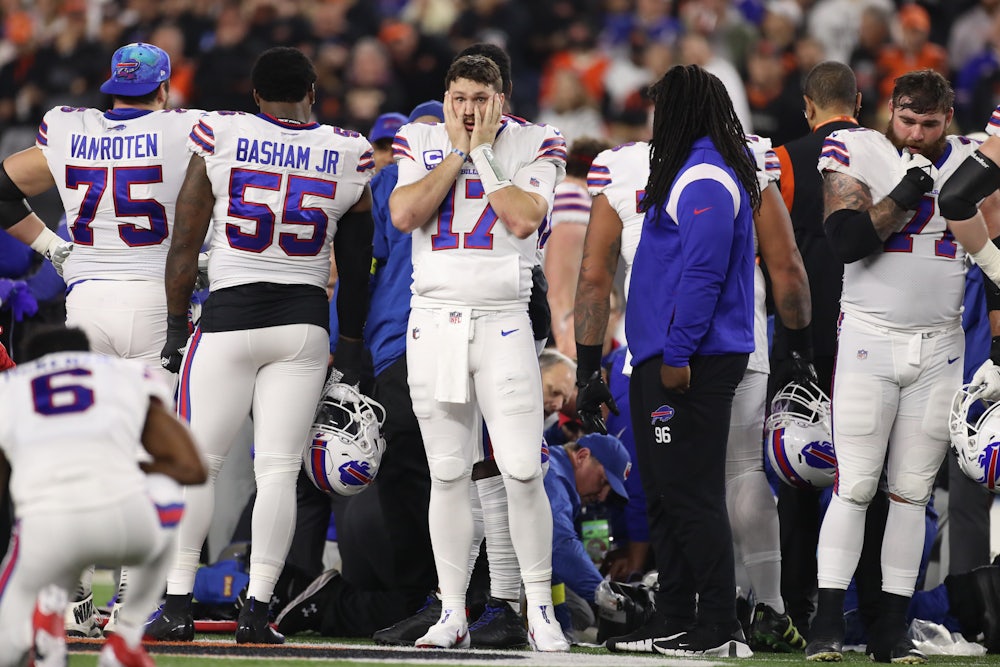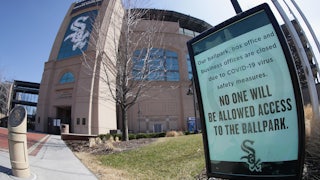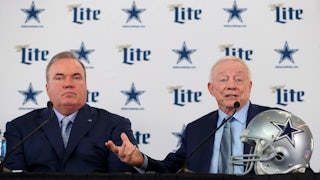On Monday evening, the NFL was faced with the easiest and most obvious decision in the world. For roughly an hour, league officials refused to make it. Buffalo Bills safety Damar Hamlin, after what looked like a routine tackle, had collapsed on the field near the end of the first quarter of the season’s final Monday Night Football game. Hamlin got up after making the hit, seemingly without much concern; seconds later, he’d flopped backward onto the field.
For several ominous minutes it wasn’t clear what had happened, but there was a palpable sense of serious concern. An ambulance rushed onto the field; players from both teams were crying on the sidelines. Hamlin received CPR for nearly 10 minutes; later in the night it was confirmed that he had suffered from sudden cardiac arrest. He is currently in critical condition in Cincinnati, where the game was being played.
It’s not clear that the game will ever resume, though the league said it won’t happen this week—making it unlikely to be held at all, given that the playoffs start in less than two weeks. It doesn’t matter, obviously. And yet, for roughly an hour, the NFL seemed to hold out hope that it would—and that night as well. It took ages for the league to do the right thing and postpone the game. It had by then been obvious from the look on the faces of every player on the field that it simply couldn’t continue.
The process behind making that decision has, somewhat typically for the NFL, been clouded by obfuscation and self-justification. Not long after Hamlin had been taken off the field, commentator Joe Buck said that league sources had given the teams five minutes to gather their emotions and get back on the field. Soon after, both coaches led their teams off the field after a brief conference. It was this act, rather than any message from the NFL, that seemed to lead to the game’s suspension. Nevertheless, hours later league vice president Troy Vincent insisted to reporters that this wasn’t the case. “What was most important was that it wasn’t about proceeding with the game,” he said on a conference call, noting that, per ESPN, “resuming play did not cross their minds.”
It’s not precisely clear what led to the game’s postponement, and we may never learn. It isn’t clear why, if Vincent’s statement is accurate, the league waited as long as it did to suspend the game indefinitely. Whatever we may end up learning about the league’s tortured process is, perhaps, a secondary concern. We have just seen the clearest reminder in years about football’s inherent risk, its danger and brutality—and the attendant, often life-shortening debilitations that come with it. Despite this, we all know that football will somehow endure.
The idea of restarting the game so soon after everyone witnessed a near-death experience seems absurd; but it’s just as bizarre that any team will play on Sunday, the final day of the NFL’s season. That they will play—and that the league and the massive economic and cultural apparatus it lugs around will quickly resume, with discussion of playoff matchups and Super Bowl odds (sponsored by DraftKings) is as inevitable as it is obscene.
Part of the reason why is because football is the most American of sports; it’s easier to contemplate the end of the world than a time in the future when the National Football League isn’t a going concern. The sport is fast and violent and lucrative; it has a momentum all its own. For years, we have known about chronic traumatic encephalopathy and other traumatic brain injuries, about racial discrimination and corruption, the fecklessness of Roger Goodell, the fact that we are watching a game that is literally shortening the lives of many of the extremely young people who play it. The fact that a game was stopped at all, even for an hour, was the strange sight, the unnatural imposition of the real world on professional sports’ most plutocratic league. It was also, as New York’s Will Leitch observed, a sign of progress in a league that has historically marched ahead regardless of any human tragedy directly or indirectly related to the sport.
There has been a great deal of talk about the moral trade-offs of football in recent years: We know this brand of entertainment permanently maims the people involved. Many of us make what we think of as moral compromises to keep watching. (Mine, incidentally, is that I only watch the Buffalo Bills, which is how I found myself watching on Monday.) But what happened on Monday is a reminder that those trade-offs may be impossible to bear. The NFL for many years resisted and covered up evidence of the long-term consequences of playing football; in recent years it has made progress in making the game less dangerous. But what happened to Damar Hamlin is a reminder that the game will never be safe. Or as The Ringer’s Kevin Clark wrote in a moving piece, “There is a limit on how safe the sport can be, and that gets thrown into our face every few weeks at the very least.”
Of course, the sights of the sport’s brutality are simply the aspect of this questionable moral arrangement that we bear witness to on game day. Many of football’s most serious dangers are abstracted or unseen. They arrive years later in the form of players suffering from premature dementia, violent mood swings, and suicidal depression. Off the field and away from the action, these are the blemishes that can be hidden away from the tens of millions who watch religiously for a third of the year.
Naturally, the players understand the risks, but it’s the league’s sheer momentum and ruthless competitiveness—these most American qualities—that renders so many of the players who take these risks expendable, both physically and economically. Last night, ESPN—after minutes of faltering coverage—aired what may have been its most clear-eyed assessment of the dangers of football. Here is what former All-Pro safety Ryan Clark, whose career ended prematurely after he collapsed on a plane due to complications involving the sport and a genetic disorder, had to say on ESPN.
When Damar Hamlin falls to the turf, and when you see the medical staff rush to the field and both teams are on the field, you realize this isn’t normal. You realize this isn’t just football. So many times in this game, and in our job as well, we use the clichés: “I’m ready to die for this. I’m willing to give my life for this. It’s time to go to war.” And I think sometimes we use those things so much, we forget that part of living this dream is putting your life at risk. Tonight, we got to see a side of football that is extremely ugly. A side of football that no one ever wants to see and never wants to admit exists. When you see both teams on the field crying in that way, your first thought is Damar Hamlin, your second thought is his family. This isn’t about a football player. This is about a human. This is about a brother. This is about a son. This is about a friend. This is about someone who is loved by so many that you have to watch go through this.
What we’ve seen since Hamlin collapsed has run the gamut, exposing all that’s good and ill about this league. The outpouring of support for Hamlin—a hardworking and charitably-minded sixth-round draft pick who has quietly been one of the league’s best success stories this year—has been moving and extraordinary. We are reminded that players who are often treated either as superhumans or as mindless automatons, who come in for hours of abuse on inane morning TV shows, are human beings. That it seems highly likely that the game was ultimately suspended because of collective action from players and coaches who refused to play another down after watching one of their friends and colleagues collapse is similarly moving. But those players and coaches could only halt things momentarily. The sport—and its attendant, inherent costs—will start up again soon and the league will roll on, with or without Damar Hamlin.






